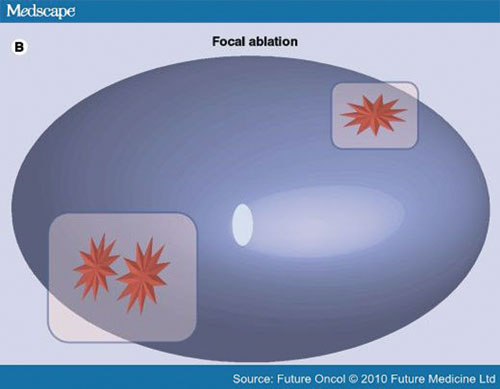When a suspicion of prostate cancer exists either due to elevated or rising serum PSA (prostate specific antigen) levels, family history of prostate cancer, or abnormal prostate on clinical digital rectal examination, consideration should be given to either confirm a diagnosis or establish that no evidence of prostate cancer is present despite abnormal clinical evaluation or laboratory tests. This is accomplished by obtaining a biopsy of the prostate gland.
In the past, before PSA testing was available, prostate biopsies were performed on patients with an abnormal prostate on clinical examination (presence of a prostate nodule or prostate hardness) in the operating room under anesthesia with large biopsy needles developed specifically to obtain liver biopsies. Since the advent of PSA testing and the development of prostate ultrasound, transrectal ultrasound-guided prostate biopsies became available in an office setting performed by an urologist. These biopsies are much more accurate in diagnosing prostate cancer.
Subsequently, additional technological developments have led to prostate magnetic resonance imaging (MRI) which is substantially more accurate in detecting prostate cancer with the ability to “fuse” prostate MRI images to prostate ultrasound images allowing more precise prostate biopsies to be obtained.
The most recent development is the ability to perform direct MRI-guided prostate biopsies with real-time MRI imaging (in-bore prostate biopsy) resulting in even greater targeting of prostate biopsies and more accurate diagnosis of clinically significant prostate cancer.
Once a diagnosis of prostate cancer has been made, consideration should be given to possible treatment options. With prostate cancer, there is no “one-size-fits-all” remedy and several treatment options are available as proper treatment requires consideration not only of the presence of prostate cancer, but also its aggressiveness, measured by certain criteria applied to prostate cancer cells microscopically designated as a Gleason score. The patient’s medical status, age, and, ultimately, the patient’s wishes must also be considered. Options include the following:
- No therapy – best considered in patients of advanced age living into their 80s and not symptomatic;
- Active surveillance – best applied when prostate cancer aggressiveness/Gleason score is low and the volume of prostate cancer is small, consisting of serum PSA level evaluations periodically and prostate re-biopsy to reassess the patient for continued surveillance or the need for more definitive therapy;
- Radical prostate surgery to surgically remove the entire prostate gland is usually performed laparoscopically and robotically in the operating room and standardly requires only an overnight stay in the hospital;
- Cryotherapy – freezing of the entire prostate under ultrasound guidance in the operating room under general or spinal anesthesia;
- Whole-gland radiation therapy – external beam intensity modulated radiation therapy/IMRT vs. proton radiation therapy vs. insertion of interstitial radioactive prostatic seed implants/brachytherapy;
- High-intensity focused ultrasound – also called HIFU, focal therapy vs. focal cryotherapy vs. focal laser ablation therapy is the most recently developed focal therapy for treatment of only the prostate cancer lesions noted on prostate MRI exam. This treatment is currently investigational.
It is important to note that while these treatment options are generally highly effective in addressing treatment of prostate cancer, no treatment is guaranteed to be 100% effective; therefore, all treatments require continued close surveillance.
While great strides have been made in curing prostate cancer especially because of early detection by PSA testing, prostate biopsy becoming more accurate, and improvements in potentially curative therapy including radical prostate surgery, radiation therapy, etc., the most significant advancement in prostate cancer treatment has been in controlling prostate cancer by either local/focal control, hormonal manipulative therapy or other new medical treatment options. These advancements are particularly effective for recurrent or metastatic prostate cancer that has spread outside the prostate, usually to bones or lymph nodes.
These treatments and technological advances allow for better evaluation and treatment resulting in patients living longer disease-free lives with normal or near normal quality of life and frequently a full lifespan. This is in marked contrast to the situation only 30 years ago before the advent of PSA testing and technology when patients were diagnosed with prostate cancer and frequently the cancer had already spread outside the prostate with little or no treatment options available.
Dr. Jeffrey Herz is a urologist and Director of Urology at Desert Medical Imaging (DMI). Bernadette M. Greenwood is Chief Research Officer at DMI and Clinical Instructor at UC Riverside School of Medicine. For more information about the prostate program at DMI, please visit www.DesertMedicalImaging.com. DMI is a member of
www.DesertDoctors.org.









































Comments (0)